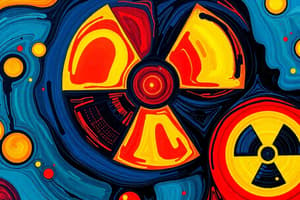Podcast
Questions and Answers
What is the primary difference between alpha decay and beta decay?
What is the primary difference between alpha decay and beta decay?
- Alpha decay involves the emission of gamma radiation, while beta decay involves the emission of protons.
- Alpha decay results in the formation of a more massive nucleus, while beta decay forms a less stable nucleus.
- Alpha decay has a longer half-life compared to beta decay.
- Alpha decay emits an alpha particle, while beta decay emits an electron or positron. (correct)
What does half-life refer to in the context of radioactivity?
What does half-life refer to in the context of radioactivity?
- The time it takes for a radioactive substance to decay half of its original amount. (correct)
- The duration within which all radioactive isotopes will completely decay.
- The time it takes for a gamma radiation emitting isotope to become stable.
- The time it takes for a radioactive isotope to transform into a stable nucleus.
In gamma decay, what type of energy is emitted by the atomic nucleus?
In gamma decay, what type of energy is emitted by the atomic nucleus?
- Electrons
- High-energy photons (correct)
- Protons
- Alpha particles
Why are half-lives considered constant and predictable for each radioactive isotope?
Why are half-lives considered constant and predictable for each radioactive isotope?
What do nuclear reactions result in?
What do nuclear reactions result in?
Which type of decay involves the emission of either an electron or a positron from an atomic nucleus?
Which type of decay involves the emission of either an electron or a positron from an atomic nucleus?
What is the primary difference between nuclear fission and nuclear fusion?
What is the primary difference between nuclear fission and nuclear fusion?
What defines a radioactive isotope?
What defines a radioactive isotope?
In what fields are radioisotopes commonly used?
In what fields are radioisotopes commonly used?
What role do radioisotopes play in medical applications?
What role do radioisotopes play in medical applications?
How do radioactive isotopes contribute to scientific research?
How do radioactive isotopes contribute to scientific research?
What is the key feature that distinguishes nuclear fission from nuclear fusion?
What is the key feature that distinguishes nuclear fission from nuclear fusion?
Flashcards are hidden until you start studying
Study Notes
Exploring Radioactivity: Decay, Half-Lives, Nuclear Reactions, and Isotopes
Radioactivity, a fascinating and pervasive aspect of our natural world, has transformed our understanding of the universe and altered human society. Let's delve into the core aspects that make radioactivity an integral part of our scientific landscape.
Types of Radioactive Decay
Radioactive decay, the spontaneous transformation of an unstable atomic nucleus into a more stable form, occurs in three primary ways:
- Alpha decay: An atomic nucleus emits an alpha particle (consisting of 2 protons and 2 neutrons) to form a less massive nucleus.
- Beta decay: An atomic nucleus emits either an electron (beta-minus decay) or a positron (beta-plus decay) along with an electron neutrino or electron antineutrino.
- Gamma decay: An atomic nucleus emits gamma radiation, high-energy photons that help remove excess energy created during previous decays.
Half-Life
Half-life, the time it takes for half of a radioactive substance to decay, is a fundamental concept in the study of radioactivity. Although each radioactive isotope has a unique half-life, it provides a constant and predictable rate of decay for that isotope. Half-lives can range from a fraction of a second to billions of years.
Nuclear Reactions
Nuclear reactions, in which nuclei undergo transformation, lead to the production of radioactive isotopes. These reactions include:
- Nuclear fission: A heavy nucleus is split into two or more smaller nuclei, releasing an enormous amount of energy in the form of heat and radiation.
- Nuclear fusion: Two light nuclei combine to form a heavier nucleus, releasing energy in the process.
Radioactive Isotopes
Radioactive isotopes, or radioisotopes, are isotopes that undergo radioactive decay. Isotopes are atoms that have the same number of protons but different numbers of neutrons. Radioisotopes play a crucial role in various fields, such as:
- Medical applications: Radioisotopes are used for diagnostic imaging (e.g., PET scans) and treatment of diseases (e.g., cancer therapy).
- Scientific research: Radioisotopes are used in studies of atomic and nuclear physics, geology, and atmospheric sciences.
- Industrial processes: Radioisotopes are used in the production of new materials, food preservation, and the detection of leaks in pipelines.
Radioactivity has transformed our understanding of the universe, improved our lives through technological advancements, and underscored the importance of managing and mitigating the risks it poses. As we continue to explore and utilize radioactive substances, we must remain vigilant and informed of their potential benefits and drawbacks.
[No references are included in this article, as per the given instructions]
Studying That Suits You
Use AI to generate personalized quizzes and flashcards to suit your learning preferences.




